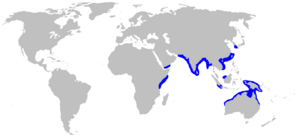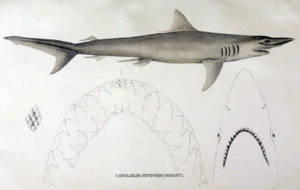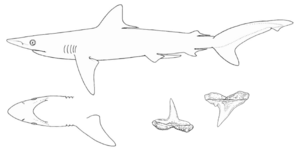Hardnose shark facts for kids
Quick facts for kids Hardnose shark |
|
|---|---|
 |
|
| Conservation status | |
| Scientific classification | |
| Genus: |
Carcharhinus
|
| Species: |
macloti
|
 |
|
| Range of the hardnose shark | |
| Synonyms | |
|
Carcharias macloti Müller & Henle, 1839 |
|
The hardnose shark (Carcharhinus macloti) is a type of requiem shark. It gets its name because the front part of its nose is very hard. This small shark has a bronze color and can grow up to about 1.1 meters (3.6 feet) long.
It has a thin body and a long, pointy snout. Its two back fins (dorsal fins) have long, stretched-out tips. You can find the hardnose shark in the warm, shallow waters of the western Indo-Pacific region. This area stretches from Kenya to southern China and northern Australia.
Hardnose sharks are quite common and like to live in groups. They hunt and eat bony fishes, cephalopods (like squid), and crustaceans (like crabs). Female hardnose sharks give birth to live young, usually one or two pups at a time. They reproduce every two years after being pregnant for about twelve months. People fish for hardnose sharks for their meat. Because they don't have many babies, the International Union for Conservation of Nature (IUCN) lists them as Near Threatened. This means they could become endangered if not protected.
Contents
What is a Hardnose Shark?
The hardnose shark was first described by two German scientists, Johannes Müller and Jakob Henle. They wrote about it in their book in 1839. They named it Carcharias (Hypoprion) macloti to honor Heinrich Christian Macklot. He was the one who found the first shark of this kind in New Guinea.
Later, in 1862, an American scientist named Theodore Gill changed its scientific name. He moved it to its own group, Hypoprion. Then, in 1985, another scientist named Jack Garrick grouped Hypoprion with Carcharhinus. So, now it is known as Carcharhinus macloti. Sometimes, people also call it Maclot's shark.
How Hardnose Sharks Look
The hardnose shark has a slim body and a long, narrow, pointed snout. Its snout is special because the cartilage inside it is very hard, which is why it's called "hardnose." Its eyes are round and fairly large. They have special protective eyelids called nictitating membranes.
The shark's mouth is curved, and it has small grooves at the corners. Its upper teeth have 29 to 32 rows. Each tooth has a narrow, smooth point with rough edges at the bottom. The lower teeth are also narrow and smooth, with 26 to 29 rows. Like other sharks, it has five pairs of gill slits for breathing.
Its pectoral fins (side fins) are short and pointed, shaped like a sickle. The first dorsal fin (top fin) is triangular and medium-sized. It starts above where the pectoral fins end. The second dorsal fin is smaller and lower. Both dorsal fins have very long tips that trail behind them.
The skin of the hardnose shark is covered in small, overlapping scales called dermal denticles. Each scale has three ridges. The shark is bronze on top and white underneath. It might have a faint light band on its sides. The tips of its fins can sometimes be lighter or darker. Hardnose sharks grow to about 1.1 meters (3.6 feet) long.
Where Hardnose Sharks Live
Hardnose sharks are common in the warm, tropical waters of the western Indo-Pacific. You can find them from Kenya to Myanmar in the Indian Ocean. This includes places like Sri Lanka and the Andaman Islands. In the Pacific Ocean, they live from Vietnam to Taiwan, southern Japan, Indonesia, New Guinea, and northern Australia.
They usually stay in shallow waters close to the shore. However, they have been seen as deep as 170 meters (560 feet). Studies show that these sharks don't travel very far. About 30% of tagged sharks were found less than 50 kilometers (31 miles) from where they were first tagged. The farthest a hardnose shark has been known to travel is 711 kilometers (442 miles).
Hardnose Shark Life Cycle and Habits
Hardnose sharks often gather in large groups. They sometimes swim with spottail sharks and Australian blacktip sharks. Male and female sharks usually stay in separate groups.
These sharks mostly eat bony fishes. They also enjoy cephalopods (like squid) and crustaceans (like crabs).
The hardnose shark gives birth to live young. This is called being viviparous. Like other requiem sharks, the baby sharks grow inside the mother. They get all their food from her through a special connection called a placenta.
Female hardnose sharks give birth every two years. They usually have one or two pups after being pregnant for about twelve months. Newborn pups are about 45 to 55 centimeters (18 to 22 inches) long. They become old enough to have their own babies when they are about 70 to 75 centimeters (28 to 30 inches) long. Hardnose sharks can live for at least 15 to 20 years.
Hardnose Sharks and Humans
Hardnose sharks are not harmful to humans. People catch them using gillnets and fishing lines. This happens in many places where they live, both by small local fishermen and larger fishing companies.
Their meat is sold fresh or dried and salted. However, because they are small, they are not a very important fish for the economy. Since they don't have many babies, they can be easily overfished. Because of this, the International Union for Conservation of Nature (IUCN) has listed them as Near Threatened.
Off northern Australia, hardnose sharks make up about 13.6% of the gillnet catch and 4.0% of the longline catch. Even with these numbers, their population there seems stable. So, in that region, the IUCN considers them of Least Concern.




